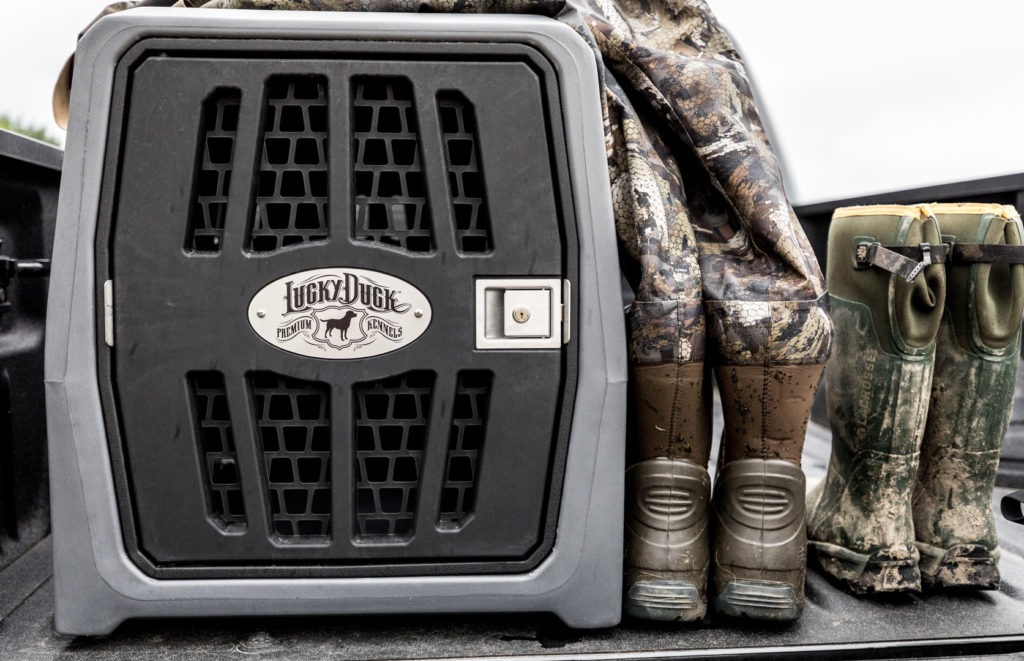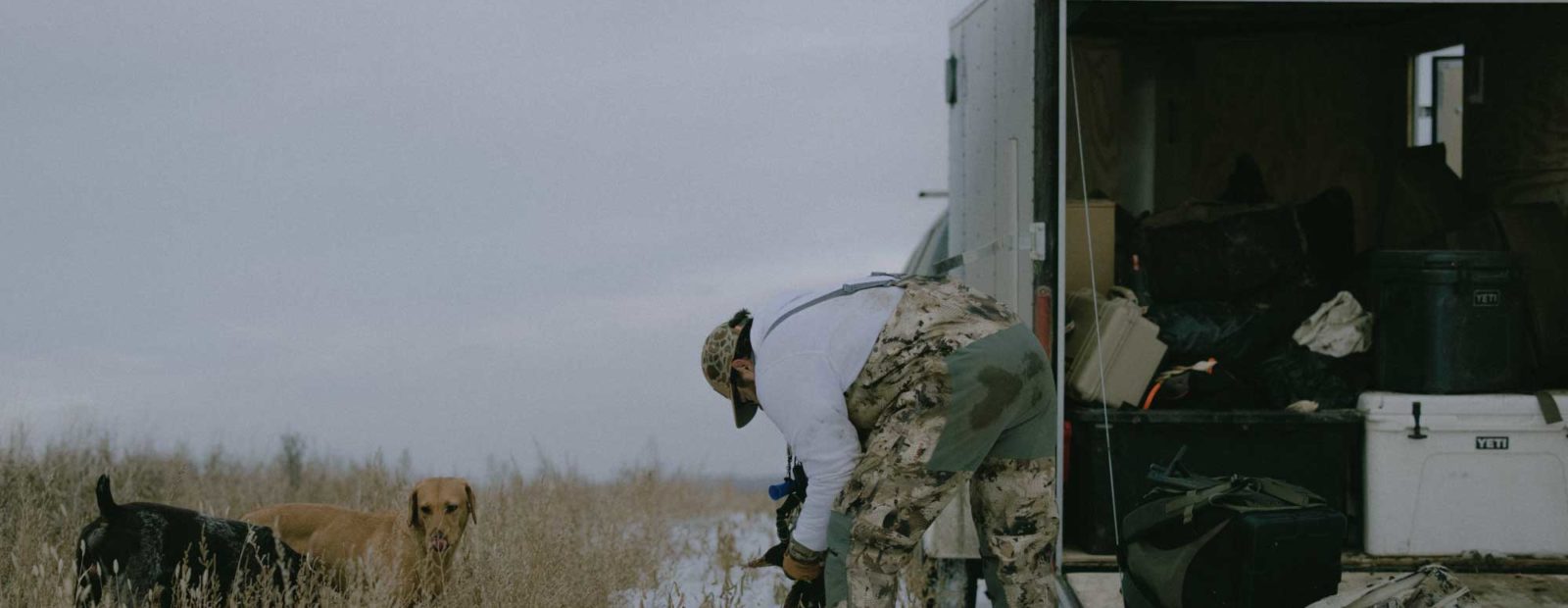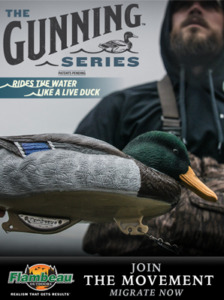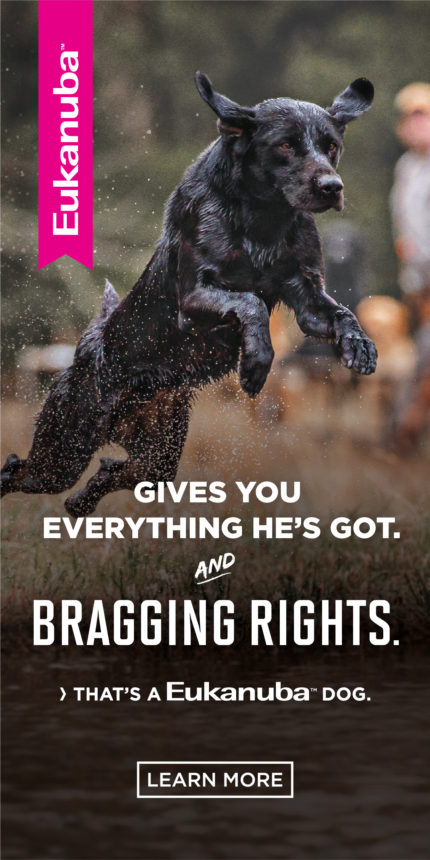As you sit at your kitchen table and go down the checklist for all of the things you’ll need ahead of your next hunting trip out of state, don’t forget to consider the needs of the 60 pounds of GO curled up at your feet. While you may have considered food and a vest to keep him warm, there’s much more to traveling with your dog than at first it may appear.
For a waterfowler, it’s hard to imagine anything more fun or more fulfilling than traveling with your number one hunting companion, your canine best friend. At times, however, nothing can be quite as stressful, either. Before you ever get to the duck hole or field, there are a great many variables which must be taken into consideration when planning a trip as well as when it comes to traveling with your dog to ensure a smooth trip and a safe arrival.
Ideally, you’ve been spending time with your dog throughout the “off-season” and working him a couple times a week. This keeps him in the game from a mental and discipline standpoint and will also serve to make sure that he has the proper endurance to make long retrieves, chase down cripples, and have the stamina to make it the whole hunt without having to make a substitution (i.e., you, the two-legged retriever.) If you haven’t been working your dog in the off-season, you’ll want to make sure that you are watching him really closely to see that he stays hydrated and isn’t wearing himself out. Dogs are amazing creatures but sometimes they don’t know when to hang it up.

If you’re going to be hunting somewhere where the climate is dramatically different, bear in mind that your dog’s coat will not be adequately suited for that environment. For example, if you’ve been in Mississippi and the coldest day you’ve seen was 50 degrees and in a day or two you’re going to be hunting in North Dakota, your dog is going to have its summer coat. You’re not out there in shorts; make sure your dog isn’t (metaphorically) in shorts, either. Be sure that you find a dog vest that will keep him warm, even when he gets wet.
My veterinarian is a duck hunter and a working-dog owner. From September to the end of January, you’ll find him and his black Lab, Scout, running after birds every chance they get. Not only is he my vet but I also have the privilege of calling him my brother and hunting buddy. Dr. Ben Kinney is a veterinarian at Somerville Animal Hospital in Somerville, Tenn. On his drive back from Nebraska, I caught up with him to talk about traveling with your best hunting buddy. As both a waterfowler and a vet, he has a unique perspective on some of the key things that every waterfowler should consider when traveling with their dog, especially on extended trips.
Here are a few of the key takeaways from our conversations that every waterfowler should consider when travelling with your dog.
Before the Trip
Rob: What are some general wellness items I need to think about before a trip?
Dr. Kinney: Before the trip, it’s always a good idea to take your dog to the vet to get him checked for general wellness. Routine wellness care and a steady regimen of heartworm, intestinal, parasite, and flea/tick prevention will go a very long way in ensuring your pet’s optimal health. This checkup is a good time to get your dog’s health certificate paperwork completed.
Rob: Outside of the physical needs of the dog to get him ready for the hunt, are there any sorts of regulatory or licensing requirements/permits that you need to check out before you head out?
Dr. Kinney: Definitely. Before traveling with your dog, you’ll want to check with your veterinarian to make sure that the state you are traveling to does not have specific entrance requirements. Some states require health certificates. This would be your Certificates of Veterinary Inspection or CVIs. Best practice is to keep these on your person or in the truck should you ever get checked. If you are traveling internationally (Canada) you will absolutely need a heath certificate from your veterinarian. Be sure to give enough time (4-6 weeks) before you leave to have all proper paperwork completed or any other additional vaccinations/treatments performed before your departure.

With regard to the 4 to 6 week time window mentioned above, you need to bear in mind that some of this paperwork has to go through local, state, and national clearing processes. While the process may not take that long, allotting for more time will make those final weeks before you head out of town considerably less stressful.
When you go to the vet, make sure he (or she) knows that you’re planning to go on a trip out of state. That way he will know what regulatory framework he’s working with so as to give you the best possible guidance. You should know (and if you don’t, your vet will) if your dog is current on heartworm, flea, and other treatments, as well.
During the Trip
Rob: Okay, so we’ve got our vaccines and our paperwork. It’s time to load up the dogs and head out. What are some things I need to think about as far as transportation goes?
Dr. Kinney: There has never been a better time to travel with your dog as far as safety goes. From a practical standpoint, if you’re going to be traveling and pulling a large dog trailer, you’ll want to make sure the trailer has been serviced recently. You know, get the bearings checked (and repacked if they need it), tires checked for uneven wear or signs of dry rot . . . make sure they’re at the right pressure. If in doubt, change the tires. They are cheap, relative to the lives they will be carrying. If you elect to travel with a kennel, I highly recommend looking into a Gunner Kennel or Lucky Duck Kennel. They are certainly an investment, but a small price to pay to ensure the safety of your best friend.
Rob: I know that some of this will be specific to the dog and you’ll need to just be receptive to the dog and pay attention to how he responds, but if this is a dog’s first trip like this, what’s a good best practice for stops and letting them out to take care of business?
Dr. Kinney: Once on the road, it is important to make sure your dog will still have plenty of access to water and time to stretch their legs. I recommend letting your dog out every 3-4 hours. Build this time into your trip. I think it’s good for their body and their mind, especially if this is their first big travel trip. I remember the first time I took Scout on her first big trip to Nebraska. Initially, she seemed a little anxious and stressed. After about the second stop, I could tell a huge shift in her demeanor. She started to relax and know what to expect. Frequent stops will also reduce wear and tear on the body and reduce things like lameness when it’s time to go to work upon arrival.
These stops give you an opportunity to check on your dog and to offer reassurance if they are getting a little stressed. Be sure and inspect your dog thoroughly at every stop. Be looking for changes in mood and general demeanor. Does your dog still look happy? Looking more stressed than normal?
Rob: If I start to sense that my dog is getting stressed – what do I do? Can my dog still be stressed out even if he isn’t shaking or looking afraid? What are some of the signs?
Dr. Kinney: Travel can take a lot out of your dog, much like us, so plan your trip accordingly. If your dog is prone to developing conditions such as diarrhea or vomiting when travelling, talk to your veterinarian to see if he (she) would be willing to prescribe any medication for the trip. I have recently become a big fan of using canine probiotics to assist with gastrointestinal health while on the road.
Rob: What about feeding/water while travelling?
Dr. Kinney:. While traveling, dogs are at a slightly increased risk of developing bowel issues. You’ll need to adjust how you feed. Reducing the amount and frequency of the feeding will cut down on soiling of the kennel as well as other gastrointestinal issues (i.e. vomiting/diarrhea.) Make sure fresh water is available. Don’t overdo the water, but again, keeping your dog hydrated can cut down on the soiling of the kennel and reduce the likelihood of the swelling of the stomach. There aren’t any hard-and-fast rules that will apply to all dogs. It’s a learning process and you’ll need to just be paying attention to your dog and make tweaks to food, water, and activity along the way to dial in what works best for your dog. These are just things that you should consider. You will need to use your judgment and knowledge of your dog.
On the Hunt
Dr. Kinney: Upon arrival, the feed should be adjusted to the level of performance demanded. Keep in mind that if you’re hunting in colder conditions, a large amount of energy is burned just for the dog to maintain its core body temperature. So offering more food at feedings will be needed. Talk to your vet about what food and protein level will be best for your dog so that a tailored feed program can be made. Feeding a high-quality performance diet is a great way to ensure your dog is getting all required nutritional support.
Rob: What are just some general things to consider while in the field?
Dr. Kinney: It’s time to hunt. Pay careful attention to your surroundings to determine how your dog could get hurt or where they could get hurt. Remember, both you and your dog are in a new place. Take stock of potential hazards and the terrain. Be looking for barbed wire fences. Noting whether the terrain is rocky, sandy, muddy, icy, or full of tall grasses (prominent seed heads) will help you know what to be looking out for as you periodically check your dog throughout the day. On one of my trips, we were in the Sandhills of Nebraska. This particular area was plentiful with sand spurs. These small, terrestrial sea urchin-looking things (the technical term) love to find their way into the foot pads of your dog. These can be incredibly painful and can make the dog temporarily lame. Once removed they can return to work!
When your dog is working, there are times when you might lose sight of your dog. Not knowing your dog’s location is every dog owner’s nightmare. Hunters are at an increased risk of losing their dogs, especially when in unfamiliar territory, or on a young pup’s first hunt. As terrible as it is to say, hunting dogs are also at risk of being stolen. Proper pet identification goes a long way to bring about your dog’s safe return.
Your dog should have a collar with your name and address, as well as several phone numbers to contact you. It is not recommended to put your pet’s name on the collar. Another great form of identification is ensuring your pet is microchipped. It is standard practice that any lost pets are immediately scanned for a microchip. In our practice it is not uncommon to find that a lost pet has been microchipped, but there is no owner information associated with the number.
PLEASE make sure your pet’s microchip is properly registered and all information is up to date Every clinic and breeder, etc., will have different policies on chip registry. Also be sure that if you move or change cell phone number that you contact the microchip company to update those records.
After the Hunt
Rob: After the hunt, what types of things do you do to make sure that your dog is good to go for the next hunt?
Dr. Kinney: At the conclusion of every hunt I carefully do a head-to-tail inspection of my dog.
Here’s my checklist:
Eyes – any redness, partially closed eyes, debris seen, etc.?
Ears – any cuts or abrasions?
Feet – any foreign objects or penetrating injuries seen in the foot pads or webbing of the feet? Tenderness to the touch?
Legs – cuts or abrasions? Any pain or areas of focal heat/ swelling? Any obvious lameness?
Skin – cuts or abrasions?
Tail – any pain on moving it up/down/ side to side? (Labs can develop “swimmer’s tail” which can be very painful)
I am very retentive when it comes to open wounds and water, especially feet. Most of our dog are used in water. Very serious infections can result after continued contact/submersion in tainted water. In my practice, I see a lot of foot infections from feet being cut up by ice while hunting in harsh conditions. One particular case, I had a dog develop septicemia as a secondary infection due to its foot injuries. Sepsis is a life-threatening blood infection from severe bacterial infection.
Rob: I know it’s always a good idea to have a first-aid kit, not only for yourself but also for the dogs. What are some things that you’d recommend as “must haves” for a field first aid kit?
Dr. Kinney: I get to cheat a little when it comes to veterinary care on the road–perk of the job. I do have a “go bag” that I carry with me. Most of the medications I carry are related to GI upset and canine-specific anti-inflammatory meds. Consult with your veterinarian before traveling and before ANY medications are given to your dog. Not all drugs are created equally and most human medicine can hurt and, in rare situations, kill your dog. Do not give your dog human anti-inflammatories like Tylenol, Advil, or Motrin. These are toxic to dogs
One medication I always make sure to carry is Benadryl. This is great for any allergic reaction or for starting to triage your dog if bitten by a snake. If the latter occurs, give the Benadryl and get to an emergency veterinarian ASAP.
The experience of hunting with your best pal can be one of the most rewarding and fulfilling experiences for a waterfowler. There’s nothing quite like watching a good dog work. With a little careful planning and forethought, you can maximize your dog’s comfort in transit, performance on the hunt, and company back at duck camp after the hunt.
Remember, your dog is so much more than a tool or piece of kit. He’s a friend and hunting partner, a member of the family. When in doubt, reach out to your vet about any other questions that you may have.
Last modified: July 19, 2022










Great Job, Rob. (no poetic comment meant). But one of the most lasting admonitions my Dad left for me, was, “…….training isn’t a destination……it’s the a JOURNEY”. And, I believe that the Navy Seal, Marcus Luttrell, was quoted saying, “Practice like you PLAY”. There’s nothing more discouraging than having planned a terrific hunting trip, only to have your canine partner, not be able to perform because of a lack of conditioning and proper nutritional preparation. It starts in the Spring before your hunt. It means that, if you’re a working stiff, you are up early in the summer and spending 30 min. working your Retriever or roading you Pointing dog. When you get to the lodge, motel or trailer after that first day, looked at the feet, under the arm pits, checked the eyes and the gums, fed and watered your partner before a good night’s rest, and the next morning your canine partner is bright eyed, wagging a tail and bounding to the tailgate, eager to hit it again, you know you’ve done your job as the senior partner on the hunting team.